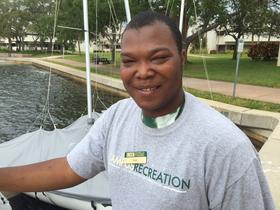Project Gives Developmentally Disabled a Chance to Go to College
A college education is generally considered a student’s best shot at getting a good job these days, and it’s often assumed most high schoolers are prepared to attend college.
But there’s one group that has been quietly excluded from that process — students with intellectual disabilities.
A program at the University of South Florida St. Petersburg is giving these students college experience that while it’s not a traditional degree, it’s giving them a head start on their career goals.
It’s a very windy afternoon at the small marina behind the University of South Florida St. Petersburg and Quan Jones is trying to keep busy.
“I work at the waterfront and we help people check out canoes, kayaks and paddle boards. This is something that I want to work at in my future,” said Jones.
Quan is like most 19-year-old college students. He loves the water, going to the movies and hanging out with college friends. And, he’s got a big, easy smile that invites you to talk to him.
And he came to the university through the Project 10 Sting Ray program. It’s a program that helps students with intellectual disabilities get into college courses and learn life skills they are going to need to get by after college.
These disabilities begin before the age of 18 and can show up as difficulties with reading, writing, math or language. Some have problems processing auditory or visual information.
“We partnered with the Florida Department of Education Bureau of Exceptional Education and Student Services and also Pinellas County Schools and USF St. Pete, and our Project 10 came together to pilot a program for students with intellectual disabilities to have the opportunity to come to college,” says Danielle Roberts-Dahm (Dom) Assistant Director of Project 10 STING RAY.
The name STING RAY is an acronym for a much longer and somewhat bureaucratic sounding title – Students Transitioning Into the Next Generation, Recognizing Alternatives for Youth.
But when it started in 2010, a lot of students with a diverse range of disabilities were coming out of high school with a non-standard diploma, similar to a GED, that didn’t easily transfer to college.
And, Dahm says,that often many of these students were missing out on the opportunity to go to college like everyone else, even though they weren’t intentionally excluded.
“So these students are graduating, their peers are going to college, their going into the military, their going into career and tech schools and many students were left behind and were not able to gain entrance and have the same opportunities that their peers were,” said Dahm.
A new Florida statute has since changed special education programs so that non-standard diplomas are no longer a stumbling block to getting into college. But, that still leaves a lot of students who want to go.
The ultimate goal is to help students in the program get a job.
Like everyone else, the STING RAY students have a range of abilities and a range of interests.
Curriculum coordinator Annie Johnson remembers one who started off with just one goal in mind.
“I had a student three years ago who, all she ever wanted to do was put cookies on a cookie sheet at Publix. But she didn’t know how to get there, she didn’t have any idea how to take the bus,” says Johnson. “Now, she comes in two days a week, in her uniform, she goes to the bus by herself, independently transports herself to a bakery on fourth street. I picked her up a couple of weeks ago, spoke to the chef. He asked her to please give him more time. He wanted to increase her hours to four hours a day because she’s been doing so well he wanted to teach her more things.”
Being on campus teaches these students communication, life and social skills.
But Dahm points out that programs like Project 10 STING RAY helps out more than just the students.
“Some of the growth that we’ve seen is obviously employment. These students who really maybe not thought of working previously or having a demanding career, do,” she says. “We had one student who was actually able to get off or reduce his dependence on government help and welfare. And he has worked full time with benefits for over two years.”
And students like Quan get to build a resume, life skills and confidence.
“I’m doing great. I’m achieving all the goals that we planned during the summer,” he says. ”
Basically, I’m popular on campus, everyone knows me and it’s like ‘wow’ ”
And his job at the waterfront is a perfect start to his career goals.
